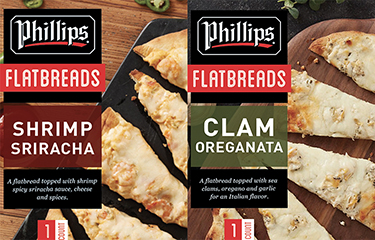Supply-chain challenges not slowing Phillips' new seafood product rollout

Despite many of the same supply chain pressures that other seafood suppliers have experienced over the last year, Phillips Foods is rolling out a myriad of new products in the first quarter of 2022.
The company has debuted unique new offerings include frozen seafood flatbreads in “Shrimp Sriracha” and “Clam Oreganata” flavors. While there are other frozen flatbreads on the market, they don’t include seafood, Phillips Vice President of Retail Sales and Marketing John Baxter told SeafoodSource.
“We are continually looking for ways to make seafood more of a staple. You don’t see flatbread with a seafood option, so – especially for pescatarians and flexitarians – it’s an easy meal option,” Baxter says.
Flatbreads, which can be marketed as an appetizer or a single-serve meal, are on “gastropub menus all over the country,” Baxter added.
Phillips is also rolling out frozen seafood pasta bowls. Flavors include Clams Alfredo and Seafood Marinara, which contains calamari, clams, octopus, and shrimp.
“This will be perfect timing for the increased trending to new single-serve meals that seem to be extremely strong at this time,” Baxter said.
During the pandemic, particularly with more people working from home, Phillips’ executives noticed the sales success of appetizers and single-serve meals.
“We wanted to take it up a notch in terms of protein and size and quality, compared to bowls that are already out there. We stayed away from rice and went with pasta, and we had raw materials that were conducive to creating those items,” Baxter said.
The new flatbreads and pasta will complement Phillips’ new soups, including Red Curry Seafood, Manhattan Clam Chowder, and Seafood Cioppino. Phillips is also realizing strong sales of its Sweet and Sour Tuna Meatballs, launched last year, as well as its Shrimp & Grits.
In the fourth quarter, Phillips noticed “steady demand” for all if its staple items, including crab cakes, according to Baxter. The company’s “holiday packs,” which included Mini Crab Cakes, Crispy Seafood Bites. and Salt & Pepper Calamari, performed “extremely well,” he noted.
For 2022, the company is looking “more closely at what items we can produce here in our U.S. plants, to soften the stress on supply chain logistics and costs of containers coming from Southeast Asia,” Phillips told SeafoodSource last fall.
On the foodservice side, the company will be developing new value-added crab, shrimp, fish, and other seafood products, “to help operators face the unique challenges of the restaurant business,” Phillips said.
The pandemic has led to high demand, but it has also plagued the industry with high crab prices and lack of availability. As one of the major crab importers, the longtime Baltimore, Maryland, U.S.A.-based supplier is feeling the pinch.
“We have been producing and bringing in more crab meat than we did [in 2020] – against the rest of the industry – but it’s still not enough to meet the demand,” Baxter told SeafoodSource last fall.
Phillips was handed numerous price increases on crab throughout the year, driven by the high costs of freight and logistics, “which have gone up tenfold,” Baxter said.
Overall, supply chain challenges are “certainly no better now” than last fall, according to Baxter.
“Container costs out of Asia continue to be high and delivery lead times continue to be pushed out further and further, putting pressure on inventory management,” Baxter said.
In the United States, “until there is an influx of new truck drivers, nothing will change overnight,” Baxter noted. “We have an industry that is labor intensive and a labor force that is not necessarily looking to this as an interesting career path.”
Plus, labor issues in the corporate offices of all major U.S. retailers are also impacting seafood suppliers.
“Either they can’t find help or they are just not willing to hire and fill important positions in the organization, including the category management team, accounting etc.,” Baxter noted. “Trying to find a live body to help with issue such as updating purchase orders, pricing changes, information on short pays, etc., has been an extremely frustrating process for the vendor and broker community.”
Photo courtesy of Phillips Foods






Share